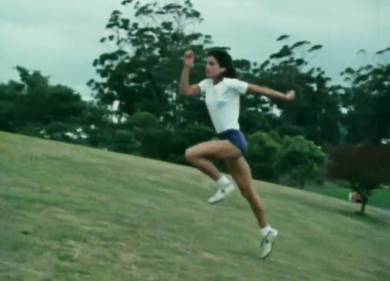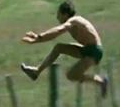
Every now and then, you come across an old movie or documentary that stops you right in your tracks. “On the Run,” a 1979 documentary about New Zealand’s legendary running coach Arthur Lydiard and his training methods is one such treat. In this 19-minute short film, you are witness to some amazing footage as Lydiard’s champion runners show how it’s done– in their training and racing, You can watch the film here in its entirety.
The film link was sent me from my friend and colleague Max Lockwood who teaches running form at Vida Gyms in Washington, D.C. There are so many terrific highlights in the documentary that it’s hard to single out one. But I was particularly impressed watching Jack Foster hurdle a fence at the start of a training run. A former cyclist, Foster ran a 2:11 marathon at age 41 and 2:20 at 50.
For those who aren’t completely familiar with Lydiard, here’s a short passage about the influential Kiwi from the new book Tread Lightly, by Pete Larson and Bill Katovsky:
Arthur Lydiard was a formerly overweight rugby player whose “radical” training methods of combining long, slow distance runs with intense workouts seemed to reap great dividends for himself and his stable of top athletes.One runner, in particular, became an international track superstar. Peter Snell took Gold in the 800 meters at the 1960 Rome Olympics.In 1962, Snell set the world record in the mile; and two years later in Tokyo, he scored an Olympics twofer: winning both the 800 and 1,500 meters.
Two other Lydiard runners won distance medals in Rome. Back home in New Zealand, Lydiard became an instant national hero. And he wisely used that fame to his advantage. Jeff Galloway explains how in his book, Galloway’s Book on Running: “After the Olympics, he was frequently invited to speak to groups of sedentary men and women in their thirties, forties, and beyond. The people he talked to began to sense that they could run gently and improve their physical condition. Running not only could take off the weight, but could be fun. Lydiard transformed the public’s image of running from an intense, tedious, painful activity into a social, civilized component of the active New Zealand lifestyle. He got them out of their chairs and onto the roads in the early ’60s, and the underground running movement began.

It should be noted that Lydiard introduced University of Oregon track coach and Nike co-founder Bill Bowerman to easy running, or what he called “jogging.” This was in the mid-60s. Bowerman later co-wrote a book called “Jogging,” and which went on to sell over a million copies.
Over the last several years I have had the privilege of meeting and speaking with many of the runners and teachers of Arthur Lydiard’s principles. Last fall, I attended and spoke on running form at the first Lydiard coaches seminar. Retired four-time Olympic distance runner Lorraine Moller, who won the bronze medal in the marathon at the 1992 Barcelona Games at the age of 37, and I also spoke at this year’s Boston Marathon.
If you want to get to the highest understanding of Lydiard’s training principles and learn from the running legends, you can attend the Lydiard Coaches Certification Seminar in Boulder, Colorado on July 27-29. I will teach a session on running form on the final day of the conference. For questions or to reserve your place email info@lydiardfoundation.org. Or call Lydiard Coaching Coordinator John Perez at 303-912-6401.

Back to “On the Run.” This jewel of a movie will show you everything you need to know about healthy running:
• Build endurance though relaxed miles in an outdoor setting.
• Develop strength and leg spring through hill bounding and skipping
• Land midfoot by watching ultra-legend Max Telford and miler great John Walker
• Do speedwork if you want to race fast on the track, but build endurance first
• It helps to be raised on a farm and have to run to and from school.
• Run on varied terrain, jump over things, and have fun.
• You are not too old to run like a gazelle in your 40’s. Just like Jack Foster.

Very cool! What great form! A reminder that sometimes to go forward, you need to look back.
I can’t imagine how he didn’t fall at the end…
What a fantastic video! Thank you. I love the the end where the guy is bombing down that hill. Pure fun.
This movie captured the optimistic spirit of the 1970s perfectly. Everybody depicted seems to be an independent owner-operator working on themselves as a project that is destined to succeed. Jack Foster’s run at the end of the movie truly captures the incredible joy of running. No heel-strikers were used in this movie!
If you enjoyed this film here is a plethora of New Zealand Olympic History
http://www.nzonscreen.com/collection/black-gold
Mark
Thanks! That was a great 20 minutes.
there is a wonderful and nourishing quality about the Lydiard movie. I cannot put my finger on it. Maybe it is the raw and pureness of just going for a run in the forest and having fun….. being able to enjoy some freedom in the natural splendor we are slowly destroying. this needs to be the connection. run in the natural world to be a part of it and find something special about yourself.
if adults show the ability to enjoy natural and play outside, then the children will follow. Children are the future and gain their habits from the adults in front of them.
there is a wonderful and nourishing quality about the Lydiard movie. I cannot put my finger on it. Maybe it is the raw and pureness of just going for a run in the forest and having fun….. being able to enjoy some freedom in the natural splendor we are slowly destroying. this needs to be the connection. run in the natural world to be a part of it and find something special about yourself.
if adults show the ability to enjoy natural and play outside, then the children will follow. Children are the future and gain their habits from the adults in front of them
I really enjoyed the article. The history of running is fascinating and it is good to see the greats in action.
I have put a link to this post on my little barefoot running blog in the best barefoot posts of the week section. I only list the 5 that I think are genuine and add to the information out there. Thankyou.
http://www.barefootbeginner.com/2012/07/21/the-best-5-barefoot-running-posts-from-the-blogosphere-this-week-are/
Growing up in the 70’s and 80’s in NZ,the likes of John Walker , Lorraine Moller, Rod Dixon, Anne Audain were all a great inspiration for me as a budding runner. As kids we all ran about barefoot and ran club meets barefoot too. Thanks for posting the video, a great watch. Lydiard is a legend.
Thank you Rebecca. Lorraine and Rod are keeping the spirit and legend alive.
Mark
As someone who started running in the UK in the early 80’s this very well produced video took me back to those early days when it was all about the joy and excitement of running. Now as a 50+ guy struggling with foot and knee problems, I search for the answers in Lydiard’s training and the thing I took away apart from the mileage was the emphasis on hills and form. All these runners are strong and exude “healthiness” if I want one thing as I head into my last third of life – it is strength and health…
Yes I also grew up here in NZ and rememeber barefoot running was the norm rather than the exception. NZ should be very proud of this man who made a real difference on the world stage. I rate him up there with the great Sir Ed Hillary as a Kiwi who has left a legacy long after his passing.
I see another great NZ runner and former Boston and NY winner Alison Roe in her younger years striding out in front at around 3.20sec of the film.
a great film from a more innocent age. it has aged beautifully.
thanks for posting!
It was a real pleasure to be part of the movie, I still get a lot of enjoyment showing this to new runners, who just love it.
Wow…thanks Max for replying. we’d love to interview you for our site. you lived the Lydiard methods. Mark